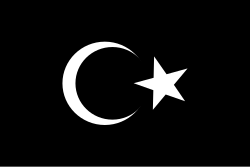Flag of Libya (construction)
The flag of the Kingdom of Libya was described in article 7 of the constitution of 7th October 1951 and officially adopted on 24 December 1951. The relevant passage in the constitution reads as follows (English translation based on The Libyan Flag & The National Anthem, a booklet issued by the Ministry of Information and Guidance of the Kingdom of Libya (year unknown), cited after Jos Poels at FOTW, 27 January 1997)
- The national flag shall have the following dimensions: Its length shall be twice its breadth, it shall be divided into three parallel coloured stripes, the uppermost being red, the centre black and the lowest green, the black stripe shall be equal in area to the two other stripes and shall bear in its centre a white crescent, between the two extremities of which there shall be a five-pointed white star.
- The red shall be sign red, and the green permanent green. The Crescent shall be on the hoistward side of the star, and the centre of the circle of which the crescent forms a part shall be in the centre of the flag. The star shall be in the open end of the crescent and one point of the star shall point to the centre of the circle. The maximum width of the 270 crescent shall equal 1/6th of its outside diameter which is 1/4th of the width of the flag. The distance between the tips of the crescent shall equal that between the uppermost and lowermost point of the star measured along a perpendicular forming the hoistward sides of these two points. The perpendicular shall form a tangent to the outside circumference of the crescent at a point equidistant from the top and bottom of the flag.
The booklet cited by way of illustration of the symbolism of the flag adds: "In the words of a well known Arab poet 'Our deeds are the colour of white, our battles of black, our meadows of green and our swords of red.' [...] The crescent is symbolic of the beginning of the lunar month according to the moslem calendar. It brings back to our minds the story of Hijra (migration) of our prophet Mohammed from his home in order to spread Islam and teach the priciples of right and virtue. The Star represents our smiling hope, the beauty of aim and object and the light of our belief in God, in our country, its dignity and honour which illuminate our way and puts an end to darkness."
But according to Barraclough's Flags of The World (1965): "The black stripe and its charges were from the black flag which the king had adopted when he was proclaimed Amir of Cyrenaica in 1947; the red stripe represents Fezzen, and the green Tripolitania."
Article 3 of the Constitutional Declaration (3 August 2011) reads (unofficial translation from the Arabic):
- "The national flag shall have the following shape and dimensions:"
- "Its length shall be double its width, it shall be divided into three parallel coloured stripes, the uppermost being red, the centre black and the lowest green, the black stripe shall be equal in area to the two other stripes together and shall bear in its centre a white crescent, between the two extremities of which shall be a five-pointed white star. "
- Dieses Werk darf von dir
- verbreitet werden – vervielfältigt, verbreitet und öffentlich zugänglich gemacht werden
- neu zusammengestellt werden – abgewandelt und bearbeitet werden
- Zu den folgenden Bedingungen:
- Namensnennung – Du musst angemessene Urheber- und Rechteangaben machen, einen Link zur Lizenz beifügen und angeben, ob Änderungen vorgenommen wurden. Diese Angaben dürfen in jeder angemessenen Art und Weise gemacht werden, allerdings nicht so, dass der Eindruck entsteht, der Lizenzgeber unterstütze gerade dich oder deine Nutzung besonders.
- Weitergabe unter gleichen Bedingungen – Wenn du das Material wiedermischst, transformierst oder darauf aufbaust, musst du deine Beiträge unter der gleichen oder einer kompatiblen Lizenz wie das Original verbreiten.
Relevante Bilder
Relevante Artikel
Flagge LibyensAm 27. Februar 2011 hat der Nationale Übergangsrat in Bengasi die alte Flagge des Königreichs als Flagge Libyens eingeführt, die erstmals am 24. Dezember 1951 eingeführt wurde. Erstmals wurde die neue Nationalflagge bei den Vereinten Nationen in New York am 21. September 2011 gesetzt. Eine neue Verfassung, die die Nationalflagge offiziell annimmt, steht noch aus. .. weiterlesen
























